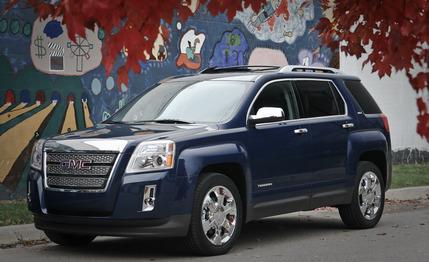
 Short Take Road Test
Short Take Road Test


When the GMC Envoy and Chevrolet TrailBlazer SUVs debuted for 2002, they shared nearly everything with the exception of their front and rear fascias, wheels, and a few minor tidbits. They were emblematic of the badge engineering that subsidized most General Motors brands for decades and that, in effect, left customers with a choice of water or water with ice.
Now, of course, the Envoy and the TrailBlazer are dead, replaced by the GMC Terrain and Chevrolet Equinox unibody crossovers. The new boys are still twins under the surface, but they’ve learned to share their mechanicals in a more subtle way, with each brand getting a distinctly styled variant. We’ve already tested the Equinox in 2.4-liter four-cylinder form, so it’s time to put the 3.0-liter V-6 through the wringer, this time wearing GMC guise.
More of the Same
Like the Equinox LT we tested, our Terrain SLT2 came in front-wheel-drive configuration but picked up a pair of cylinders that cost an extra $1500. The V-6 option musters 264 hp at 6950 rpm and 222 lb-ft of torque at 5100 rpm and is mated to a different six-speed automatic transmission than that of the four-cylinder. The optional mill increases towing capacity by 2000 pounds over that of the four—to 3500 pounds—so if you intend to haul anything larger than a small utility trailer or a pair of Jet Skis, be prepared to plunk down that premium.
The Terrain doesn’t even try to be sporty. Its 0-to-60-mph time of 7.5 seconds and quarter-mile run of 15.9 seconds at 89 mph are mediocre for its class, and the Terrain lacks midrange torque, meaning it feels slower than it is unless you’re really wailing on it. Skidpad grip is also ordinary at 0.78 g, but the Terrain proved it’s not a total couch potato in the braking test, slowing from 70 mph in 161 feet—just six feet longer than a Porsche Boxster S. That’s quite a remarkable feat for something weighing two tons, although the brake pedal feels a bit too gooey.
Thirsty and Vague
The EPA estimates this Terrain’s mileage at 17 mpg in the city and 25 mpg on the highway, but note that horsepower and torque peaks come near the very top of the rev range. Keeping that in mind will help you cope with constantly holding your right foot flat to the floor while the wheezy six struggles to adequately motivate a hefty 4008 pounds. Doing so, we managed 17 mpg overall, which isn’t great. But it’s not awful, either, since we got 18 mpg from the four-pot Equinox, which was 256 pounds lighter. Despite the different gearboxes mated to the two engines, the programming seemingly carries over; the V-6’s automatic is also never satisfied with its gear selection, continuing to jump around even when cruise control is set. Given all that, any buyer unwilling to pussyfoot the Terrain is highly unlikely to see mileage returns anywhere close to the upper end of the EPA estimate.
Along with the V-6 option arrives the replacement of the four’s electric power-steering system with a hydraulic rack-and-pinion setup. A hydraulic rack typically livens things up, but such is not the case with the Terrain. It provides as little sensation as does the electric setup, which is a shame, since you’ll be turning lock-to-lock several times because of the Terrain’s 42.6-foot turning circle, although our tester’s optional 19-inch chrome-clad wheels ($900) were partly to blame. That turning circle, incidentally, is higher than a full-size Yukon’s by nearly four feet and is only slightly smaller than the giant Yukon XL’s.
A Definite Improvement
Although it seems like all we did was run down a laundry list of faults, the Terrain isn’t a bad vehicle overall—it’s just not a fantastic one, especially in such a competitive segment. What it is, though, is a substantial upgrade from GMCs past, providing a comfortable means of transportation with a roomy back seat and relatively quiet ride.
Priced at about $1000 to $2000 over the Equinox, depending on equipment level, the GMC offers more standard features, such as tinted glass, fog lamps, floor mats, a USB port, and a back-up camera. And the Terrain’s styling has grown on us—especially in dark colors—making a much bolder statement than the Equinox’s more anonymous, softer lines. The stylistic disparity offers a real choice between Chevy and GMC, which is more than the General offered before. Hooray for that, right?